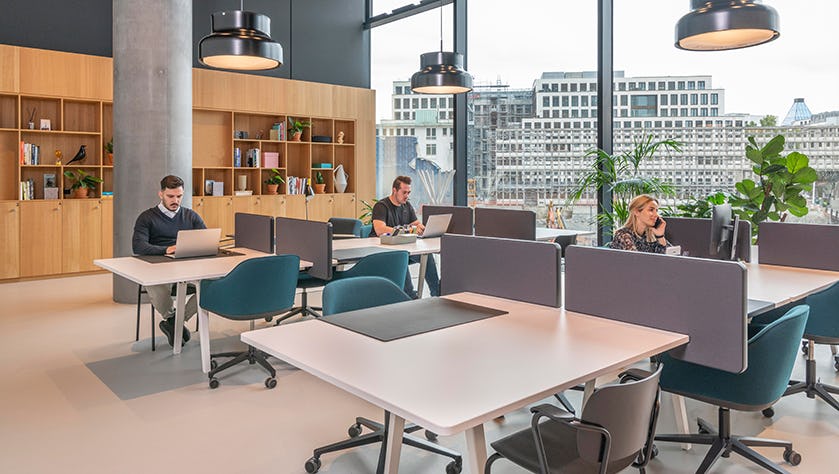
Hybrid working is not only better for our work-life balance but can also deliver many sustainability benefits.
The blue skies seen over previously smog-bound global cities during periods of lockdown were a graphic demonstration of how the environment – and our own health – can benefit from reduced commuting. But cleaner air is not the only sustainability benefit that comes from hybrid working, which lets people work remotely at home and at local workspaces, making only the occasional visit to head office.
In fact, it can play a major role in supporting a number of the United Nations’ 17 Sustainable Development Goals for 2030, allowing businesses to easily reap green dividends in areas such as sustainable cities and communities, clean energy and climate action, gender equality, and good health and wellbeing.
“There is no doubt that sustainability is now very much front of mind for companies around the world – and they know this is something their customers expect,” says Mark Dixon, Founder and CEO of Spaces’ parent company IWG. “At IWG, we believe that the adoption of a hybrid working model can be a major pillar in any company’s ESG agenda. And it can also be the foundation of a new approach to work and life that benefits both the planet and its people.”
To give one example, the hybrid model allows companies to downsize their HQ, as not all employees need to be present at any one time. This can significantly reduce their energy consumption (much of which is wasted in vast buildings), adding to the reduction in their carbon footprint already achieved by cutting down the need for their employees to commute every single day of the week.
Reinvent, recycle and rebuild
According to IWG research, by enabling people to work closer to home every Spaces location can, on average, save 7,416 commuting hours per year, equating to 118 metric tonnes of carbon. But what about the design of the workplace itself?
Last year, Spaces opened a groundbreaking new location in Oslo. Spaces Tullinløkka was created in an entirely emission-free construction project – using wholly recycled, rescued and upcycled materials. The project was a partnership between Spaces, architect Scenario Interior Architecture Design and the building’s owner, Entra ASA. They took a disused 1950s office building in the centre of Oslo with the aim of making the renovation project as green as possible.
The design team found steel beams, window panes, bricks, wooden benches and bathroom sinks from demolished buildings across the city, or left over by manufacturers and destined for landfill. This careful reuse of reclaimed materials means the site produced zero carbon emissions.
Spaces Omniturm in Frankfurt is spread across five floors inside Germany’s first mixed-use skyscraper. A key feature of the building is its solar protection glazing. This glass has a special coating designed to reduce the amount of heat entering a space, reflecting and absorbing light as well as filtering it for reduced glare. This helps to reduce the need for air-conditioning and artificial light and heat, ultimately cutting the building’s carbon footprint.
The Omniturm also collects and makes use of rainwater, employs LED lighting, has plentiful parking space for bicycles and offers charging stations for electric vehicles.
That leads us on to the recent announcement that a number of Spaces locations in the UK will have electric vehicle (EV) chargers, supplied and installed by EV charging specialist Mer. The first chargers have already appeared at Spaces Globe Park with more to follow.
All of this will help the hybrid workforce, and their employers, to operate more sustainably.
Good health and gender equality
There are also various health and wellbeing benefits that come from hybrid working. Cutting down on stressful commuting gives us more time for health-promoting activities such as exercising and sleeping. And walking or cycling to a local flexspace brings added health benefits. A Slack global survey of 9,000 knowledge workers looked at the peace of mind that comes from working close to home and concluded: “With more time and fewer office stressors, on average, they seem to experience a boost in their quality of life.”
And the hybrid working model can play a key role in levelling up the gender imbalance in many workplaces, where women are often forced to do a ‘double shift’, doing a full day of work while also caring for children or other family members. If both parents in a family are working in a hybrid way, it is easier to achieve a more equitable split of household responsibilities.
The increased recognition of the green dividends brought by hybrid working is one of ten trends identified in IWG’s white paper, The Future of Work: a trends forecast for 2022.
Find out how Spaces can help you and your company transition towards a hybrid solution.
Enjoy this? You might also like these Spaces stories:
A glimpse of a greener workspace
Green Spaces: four green and eco-friendly flexspaces
Spaces Oslo: the new building created with zero carbon emissions
Share this article
 Read now The trends shaping work in 2022: hyper flexibility
Read now The trends shaping work in 2022: hyper flexibility
 Read now The trends shaping work in 2022: productivity metrics
Read now The trends shaping work in 2022: productivity metrics